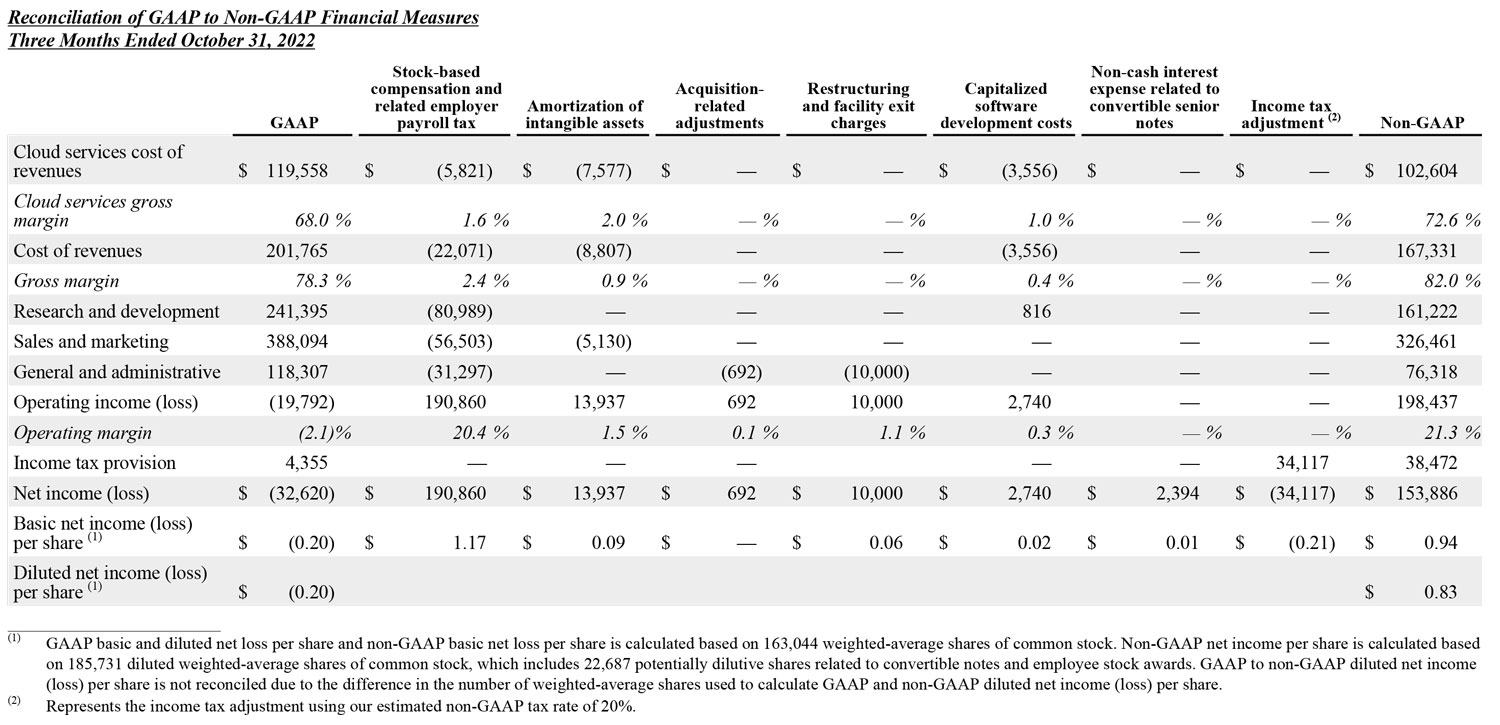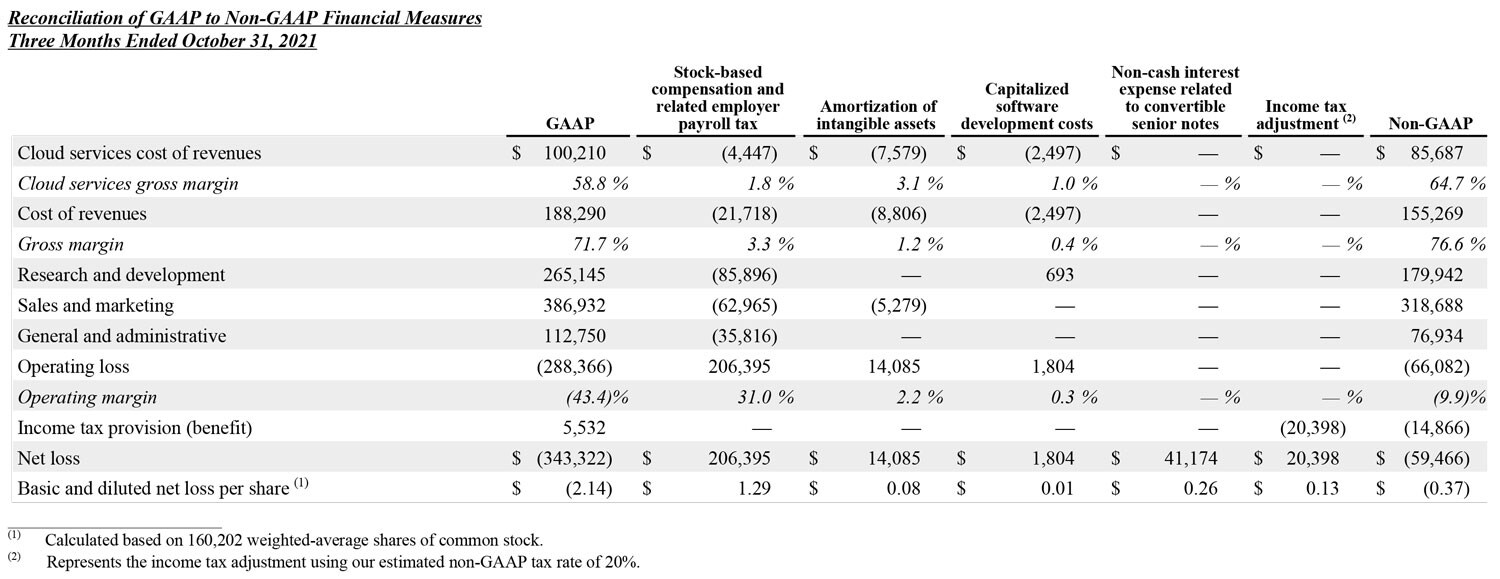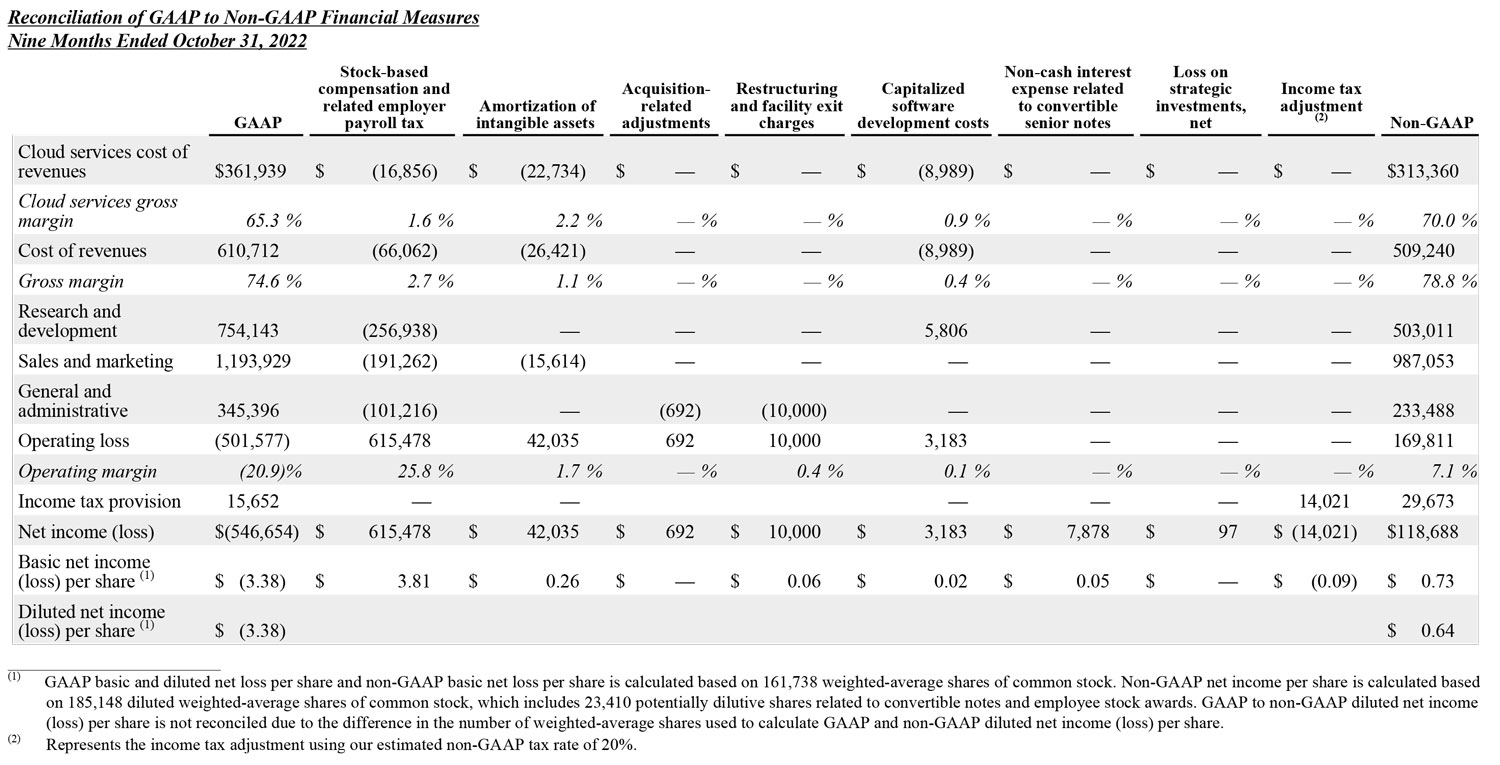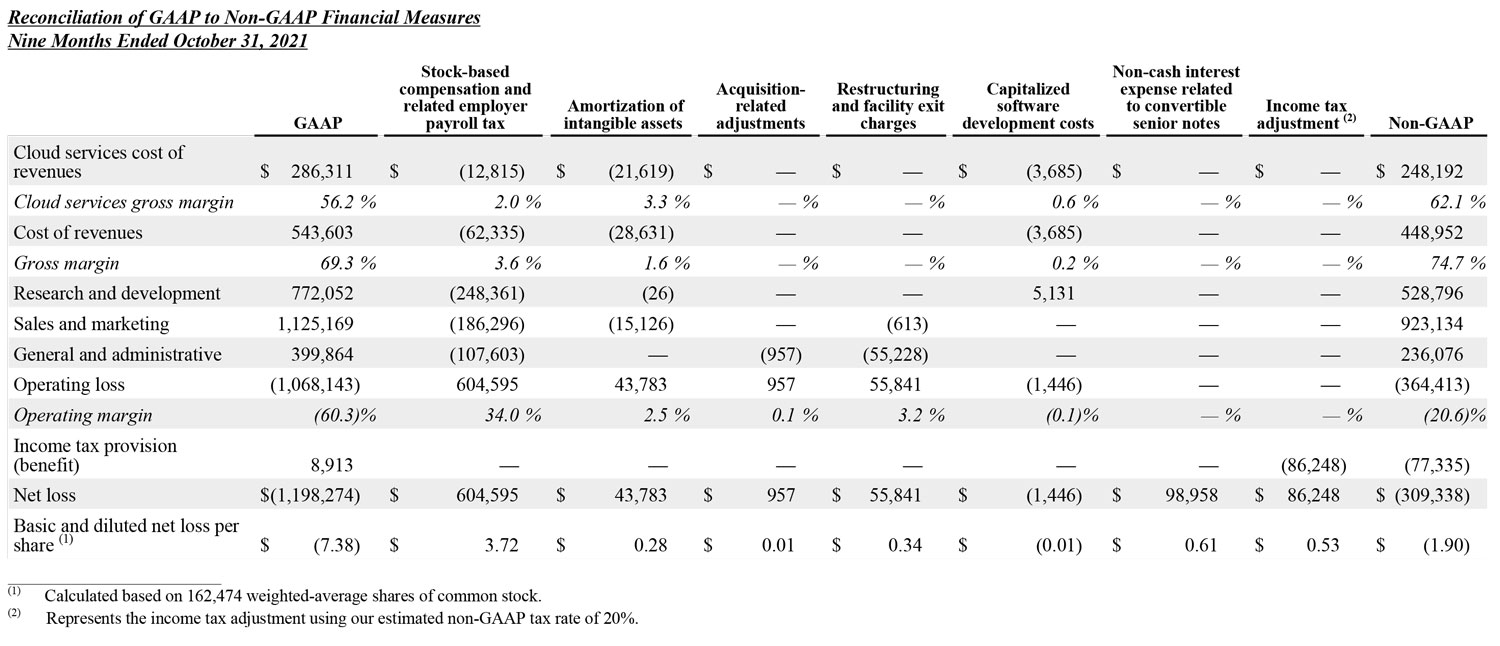November 30, 2022 – Splunk Inc. (NASDAQ: SPLK), the data platform leader for security and observability, today announced results for its fiscal third quarter ended October 31, 2022.
Third Quarter 2023 Financial Highlights
- Total revenues grew 40% to $930 million year-over-year.
- Cloud revenue grew 54% to $374 million year-over-year.
- GAAP operating margin was (2.1%); Non-GAAP operating margin was 21.3%.
- GAAP EPS was $(0.20); Non-GAAP EPS was $0.83.
- Cloud Dollar-Based Net Retention Rate was 127%.
- Customers with total ARR greater than $1 million grew 19% to 754 year-over-year.
“We delivered another solid quarter, with total revenues up 40 percent year-over-year,” said Gary Steele, President and CEO of Splunk. “Our results underscore the value our customers place in Splunk. The world’s largest and most innovative enterprises continue to invest in our platform and make their businesses more resilient through faster insights and action across security, IT and DevOps.”
“We remain focused on balancing long-term durable growth with profitability,“ continued Steele. “In addition to our strong top line results, we also made good progress on our expense reduction during the quarter. As a result, we are increasing our full-year outlook for total revenues, profitability and free cash flow.”
Q3 2023 Business Highlights
- Splunk Named a Leader for the Ninth Consecutive Time in 2022 Gartner® Magic Quadrant™ for Security Information and Event Management* (SIEM): Splunk has continued to innovate its flagship security solution, Splunk Enterprise Security, as well as the rest of the organization’s integrated security portfolio including Splunk Intelligence Management, Splunk SOAR Cloud, Splunk Enterprise 9.0 and Splunk Cloud Platform.
- Splunk Among Top Cybersecurity Leaders Contributing to the Open Cybersecurity Schema Framework (OCSF) Project: Eighteen technology and cybersecurity leaders recently launched an open-source project that defines a common standard for cybersecurity data. The OCSF project will help organizations detect, investigate and stop cyberattacks faster and more effectively by removing time-consuming, up-front normalization tasks.
- Splunk Wins Several Awards for Cybersecurity Innovation and Best Places to Work: Splunk won the 2022 SC Award for Best SIEM for Splunk Enterprise Security and six 'Best of' awards resulting from customer reviews on TrustRadius for Splunk Enterprise Security, Splunk IT Service Intelligence and Splunk SOAR. Splunk was also selected by Great Place to Work® as one of the 2022 Best Workplaces in Technology and as one of the 2022 Best Workplaces for Women.
- Splunk and AWS Sign a New Five-Year Strategic Collaboration Agreement: The agreement underscores each organization’s commitment to enable joint customers to innovate with confidence, migrate and modernize existing environments with end-to-end cloud and hybrid visibility, and scale without limits. Together, Splunk and AWS elevate customer experiences with real-time, full-stack visibility into applications and AWS services while also providing data-driven SIEM and security automation to improve productivity and protect enterprises from security risks.
- Bridging the Data Divide: Splunk continued to spotlight the data divide’s impacts and possible solutions across multiple events hosted by the United Nations and the Atlantic Council.
- Splunk Names New Chief Information Security Officer, Chief People Officer and Platform General Manager: Splunk appointed Jason Lee as its Chief Information Security Officer (CISO), Sharyl Givens as Chief People Officer and Tom Casey as Senior Vice President and General Manager, Platform.
- Splunk Board of Directors Appointments: Richard P. Wallace, President and CEO of KLA Corporation, and David Tunnell, Partner at Hellman & Friedman, were appointed to the Splunk Board of Directors. It was announced that Stephen G. Newberry will be stepping down from the Board, joining Sara Baack, as previously announced.
Financial Outlook
The company is providing the following guidance for its fiscal fourth quarter 2023 (ending January 31, 2023):
- Total revenues are expected to be between $1.055 billion and $1.085 billion.
- Non-GAAP operating margin is expected to be between 23% and 26%.
The company is updating or reaffirming the following guidance for its fiscal year 2023 (ending January 31, 2023):
- Total revenues are expected to be between $3.455 billion and $3.485 billion (was previously between $3.35 billion and $3.4 billion).
- Non-GAAP operating margin is expected to be between 12% and 13% (was previously 8%).
- Total ARR is expected to be approximately $3.65 billion; Cloud ARR is expected to be between $1.775 billion and $1.8 billion (was previously $1.8 billion).
- Free Cash flow is expected to be at least $420 million (was previously $400 million).
Conference Call and Webcast
Splunk’s executive management team will host a conference call beginning at 1:30 p.m. PT (4:30 p.m. ET) today to discuss financial results and business highlights. Interested parties may access the call by dialing (800) 715-9871 in the U.S. or (646) 307-1963 from international locations and referencing conference ID 5441433. A live audio webcast of the conference call will also be available through Splunk’s Investor Relations website at http://investors.splunk.com/events-presentations. An audio webcast replay of the call will be available for the next 12 months.
Safe Harbor Statement
This press release contains forward-looking statements that involve risks and uncertainties, including statements regarding Splunk’s long-term prospects, including Splunk’s guidance for total revenues and non-GAAP operating margin targets for the company’s fiscal fourth quarter 2023 and total revenues, non-GAAP operating margin, Total ARR, Cloud ARR, and free cash flow for the company’s fiscal year 2023; our global presence and trends in customer demand and engagement; statements regarding our operating expenses, growth and profitability; statements regarding our collaboration agreement with AWS and its benefits to us and our customers; statements regarding our products, projects, technology and ongoing product development; statements regarding our market opportunity; the market for data-related products and the importance of data and our ability to leverage these trends; expectations for our industry, business and products, such as our business model, customer demand and trust, our partner relationships, customer success and feedback, expanding use of Splunk by customers, and expected benefits and scale of our products. There are a significant number of factors that could cause actual results to differ materially from statements made in this press release, including: the macroeconomic environment, including inflationary pressures, economic uncertainty and impacts on information technology spending; risks associated with Splunk’s growth, particularly outside of the United States; Splunk’s inability to realize value from its significant investments in the company’s business, including product and service innovations and through acquisitions; Splunk’s shift from sales of licenses to sales of cloud services which impacts the timing of revenue and margins; a shift from generally invoicing multi-year contracts upfront to invoicing on an annual basis, which impacts cash collections; Splunk’s transition to a multi-product software and services business; Splunk’s inability to successfully integrate acquired businesses and technologies; Splunk’s inability to service its debt obligations or other adverse effects related to the company’s convertible notes; COVID-19 and related public health measures on our business and the business of our customers, as well as the impact of new variants on the overall economic environment, including customer buying capacity, urgency and patterns; and general market, political, economic, business and competitive market conditions.
Additional information on potential factors that could affect Splunk’s financial results is included in the company’s Quarterly Report on Form 10-Q for the fiscal quarter ended July 31, 2022, which is on file with the U.S. Securities and Exchange Commission (“SEC”) and Splunk’s other filings with the SEC. Splunk does not assume any obligation to update the forward-looking statements provided to reflect events that occur or circumstances that exist after the date on which they were made.
*Gartner, Inc., 2022 Gartner Magic Quadrant for Security Information and Event Management, Pete Shoard, Andrew Davies, Mitchell Schneider, October 10, 2022.
Gartner and Magic Quadrant are registered trademarks and service marks of Gartner, Inc. and/or its affiliates in the U.S. and internationally and are used herein with permission. All rights reserved.
Gartner does not endorse any vendor, product or service depicted in its research publications, and does not advise technology users to select only those vendors with the highest ratings or other designation. Gartner research publications consist of the opinions of Gartner's research organization and should not be construed as statements of fact. Gartner disclaims all warranties, expressed or implied, with respect to this research, including any warranties of merchantability or fitness for a particular purpose.
Splunk Inc. (NASDAQ: SPLK) helps organizations around the world turn data into doing. Splunk technology is designed to investigate, monitor, analyze and act on data at any scale.
Splunk, Splunk>, Data-to-Everything and Turn Data Into Doing are trademarks and registered trademarks of Splunk Inc. in the United States and other countries. All other brand names, product names, or trademarks belong to their respective owners. © 2022 Splunk Inc. All rights reserved.
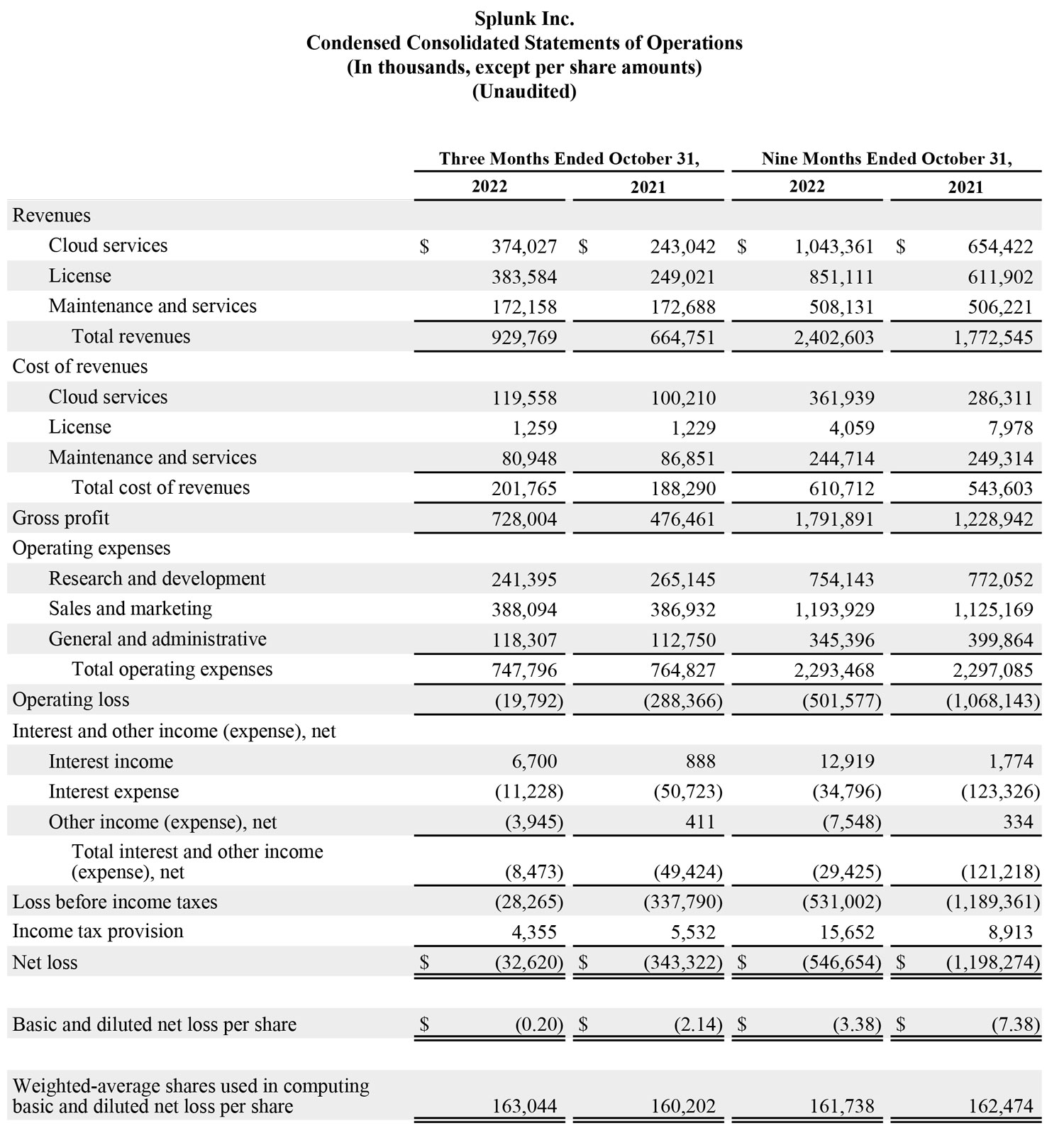


Splunk Inc.
Operating Metrics
Total Annual Recurring Revenue (“Total ARR”) represents the annualized revenue run-rate of active cloud services, term license and maintenance contracts at the end of a reporting period. Cloud Annual Recurring Revenue (“Cloud ARR”) represents the annualized revenue run-rate of active cloud services contracts at the end of a reporting period. Each contract is annualized by dividing the contract value by the number of days in the contract term and then multiplying by 365.
Non-GAAP Financial Measures and Reconciliations
To supplement Splunk’s condensed consolidated financial statements, which are prepared and presented in accordance with generally accepted accounting principles in the United States (“GAAP”), Splunk provides investors with the following non-GAAP financial measures: cloud services cost of revenues, cloud services gross margin, cost of revenues, gross margin, research and development expense, sales and marketing expense, general and administrative expense, operating income (loss), operating margin, income tax provision (benefit), net income (loss), net income (loss) per share and free cash flow (collectively the “non-GAAP financial measures”). These non-GAAP financial measures exclude all or a combination of the following (as reflected in the following reconciliation tables): expenses related to stock-based compensation and related employer payroll tax, amortization of intangible assets, acquisition-related adjustments, restructuring and facility exit charges, capitalized software development costs and non-cash interest expense related to convertible senior notes. The non-GAAP financial measures are also adjusted for Splunk's estimated tax rate on non-GAAP income (loss). To determine the estimated non-GAAP tax rate, Splunk evaluates financial projections based on its non-GAAP results and the tax effect of those projections. The estimated non-GAAP tax rate takes into account many factors including our operating structure and tax positions. The non-GAAP tax rate applied to the three and nine months ended October 31, 2021 was 20%. The applicable fiscal 2021 tax rates are noted in the reconciliations. In addition, non-GAAP financial measures include free cash flow, which represents operating cash flow less purchases of property and equipment. Splunk considers free cash flow to be a liquidity measure that provides useful information to management and investors about the amount of cash generated or used by the business.
Splunk excludes stock-based compensation expense because it is non-cash in nature and excluding this expense provides meaningful supplemental information regarding Splunk’s operational performance and allows investors the ability to make more meaningful comparisons between Splunk’s operating results and those of other companies. Splunk excludes employer payroll tax expense related to employee stock plans in order for investors to see the full effect that excluding that stock-based compensation expense had on Splunk’s operating results. These expenses are tied to the exercise or vesting of underlying equity awards and the price of Splunk’s common stock at the time of vesting or exercise, which may vary from period to period independent of the operating performance of Splunk’s business. Splunk also excludes amortization of intangible assets, acquisition-related adjustments, restructuring and facility exit charges, capitalized software development costs and non-cash interest expense related to convertible senior notes from the applicable non-GAAP financial measures because these adjustments are considered by management to be outside of Splunk’s core operating results.
There are limitations in using non-GAAP financial measures because the non-GAAP financial measures are not prepared in accordance with GAAP, may be different from non-GAAP financial measures used by Splunk’s competitors and exclude expenses that may have a material impact upon Splunk’s reported financial results. Further, stock-based compensation expense has been and will continue to be, for the foreseeable future, a significant recurring expense in Splunk’s business and an important part of the compensation provided to Splunk’s employees. The presentation of the non-GAAP financial measures is not intended to be considered in isolation or as a substitute for, or superior to, the financial information prepared and presented in accordance with GAAP. Splunk uses these non-GAAP financial measures for financial and operational decision-making purposes and as a means to evaluate period-to-period comparisons. Splunk believes that these non-GAAP financial measures provide useful information about Splunk’s operating results, enhance the overall understanding of past financial performance and future prospects and allow for greater transparency with respect to key metrics used by management in its financial and operational decision making. In addition, these non-GAAP financial measures facilitate comparisons to competitors’ operating results. The non-GAAP financial measures are meant to supplement and be viewed in conjunction with GAAP financial measures.
The following tables reconcile Splunk’s GAAP results to Splunk’s non-GAAP results included in this press release.

